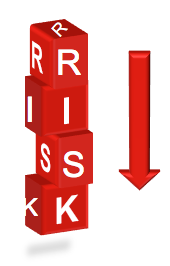Even though it is not necessary to exit trades early to be profitable, it really can help to be even more profitable. Closing option positions, which reach 50% or another percentage of the max profit really is a good idea. Most traders aren’t aware of this because it seems like a bad idea. Most traders think closing out a position at half the profit decrease the overall profitability of a strategy because you are getting less money. Even though this might seem to be the case, it really is not. In this article, I will list four big reasons why closing trades early at a smaller profit actually increases the profitability and is a very good idea.
1. Guaranteed Winners
If you exit a trade early at less than max profit, it will be a guaranteed win. If the position already is let’s say at 50% of max profit, it is a profitable trade if you close it. This means that you already made it. If you do not close it early, it is not a guaranteed profit. The position can still turn around and become a losing position. Often it is not worth the risk to hold a trade and hope to reach max profit. This means closing trades early will actually increase your win rate, because you close trades as soon as they reach your profit target and don’t let them turn into losses.
2. More Trades
If you close positions early you will be able to open new trades sooner. This means that you allocate your money for a shorter period of time per every trade. So you’ll be able to enter more trades. High probability option premium selling is all about consistency and making as many trades as possible. This is exactly what closing positions early will enable. You will be able to take the profit earlier in an expiration cycle and open new ones faster, thus trading more in total.
3. Assignment Risk
If you choose to exit trades early you will most definitely be assigned stock much less. The less time an option has until expiration, the more likely it is to be exercised. Around 80% of options are exercised in the last week of an expiration cycle. This is because there only is little extrinsic time value left in this last week. Therefore it won’t be more profitable to close out an option position and then buy the stock.

Closing option positions early will often avoid these last days/weeks of an expiration cycle and thus mitigate the risk of getting assigned. This, of course, is a very good thing, especially for traders with smaller accounts, which may have trouble handling an assignment.
4. Gamma Risk
Just like you learned in this article the option Greek Gamma measures the rate of change of Delta for every $1 move in the underlying. Just like the price of your option or underlying, Gamma also changes all the time. Gamma increases the closer you get to expiration. What this means is that when you get closer to expiration the value of your option contract becomes much more sensitive to price changes in the underlying. Delta may change much faster than it did earlier in the expiration cycle. This means your probability of losing/winning may also be more volatile. For every $1 move in the underlying price, the value of the option contract may increase/decrease much more than earlier in the expiration cycle. Gamma is negative for short positions and positive for long positions. This means that for every $1 move in the underlying a short positions loses more and more of its value. Long positions, on the other hand, lose less and less for every move. Gamma risk or directional risk is something an option trader should definitely be aware of, especially in the last weeks of an expiration cycle.
Summed up: the closer you get to expiration, the more money you can lose from a small move in the underlying because Gamma increases the closer you get to expiration. Closer to expiration (with a high Gamma) you will lose much more from a few dollar change in the underlying price than earlier in the expiration cycle. This is also the reason why it is not necessarily very good to sell short-term options, even though time decay is highest in the last week before expiration.
Conclusion
As you clearly can see exiting positions early, before you reach max profit has many benefits. Doing this will increase your win rate and your overall profit long term. Additionally, it will mitigate different kinds of risk like the risk of getting assigned and gamma risk. Even though you don’t have to do it to be profitable, I would still highly recommend to do it. Exiting trades early won’t require a lot of effort, but it will improve your option trading a lot. I advise to close out positions at 50% of the maximum profit. If you want you still can go higher, but many studies have shown that 50% of the max gain is a very ideal point to exit. To consistently exit at 50% it would help to set alerts when entering into new positions. You also could send out a closing order at 50% of the max profit as soon as you enter. As soon as the option reaches 50% of the max gain, the order should get filled and automatically close the position.
I really hope that you are enjoying this article and the intermediate options course. If you are enjoying it, feel free to share what we are doing here, so others can get to know. If you have any questions left, don’t hesitate to ask them right in the comment section below.
This Article is part of the Advanced Option Trading Course. If you are reading the article as a part of the course, you can continue to the next lesson: HERE


Hey Louis! Very professional page in all respects. Serious, financial copy easily rivaling nearly any newsletter or blog out there. Certainly not for the novice investor. I have been educating myself for the past year and some of the terminology and concepts you indicate and refer to remain a bit too advanced for me. However, at the end you do mention that this article is part of an intermediate level lesson so that settles that. Love the way you have your page so very well organized. Good work!
Hey Luis thanks for the comment,
If you are interested in the intermediate course, you should definitely check it out here.
Otherwise, you could also start with the beginner course.
Hey,
Thanks for sharing this post. I think this article proves what I have always believed when it comes to trading. Collecting small profits overall results in making more in the long run.
Plus, it reduces your risk.
Which is the most important factor of all. Taking the risk in exchange for hopes of MAX profit is not wise; especially if you’ve just started trading.
The fact that the sooner you close, the more you can trade is also a plus.
Cheers,
Diana
Excellent article Louis. You mention that there are many studies that show that 50% of max profit is an ideal exit point. Do you have any references for this as I would love to delve a little deeper and get some background info.
Chears
Great question. Sadly, I wrote this article a while ago, so I can’t remember exactly what studies I looked at when writing the article. But I found some over at TastyTrade HERE (the research videos)
And a specific video HERE.
Otherwise, I am pretty confident that Kirk over at OptionAlpha has some backtesting on this as well.
But note that the the ‘ideal’ take profit target depends on the option strategy you are using. This article is part of an article series in which I discuss an options trading style. In it I mainly recommend credit spreads (and iron condors…). Thus the 50% take profit target is pretty good for these strategies. Other strategies may benefit from a different profit target. I may have stated this somewhat unclear in this article.
I really hope this helps.
Hi Louis. Thanks for all great articles you wrote. I’ve learnt so much. I have a question about closing position early though. For example, I have a Short Put Vertical position at the strike price that is currently at OTM and I don’t think it will move to ITM until the expiration because the strike price is much lower than the current price (like 10% lower). Shouldn’t I hold this position until expiration or near expiration especially near the expiration which the premium drops very fast? Also, in this case I’m not in the risk of getting assigned. No incoming event. So what’s the risk? I mean the asset price could possibly move abruptly but that’s not a high chance.
Hi,
Sorry for the late reply. First of all, you could check out my article on option adjustment strategies. In it, I cover how to adjust different option strategies, including vertical spreads.
Here are some things you should consider for your position:
How close is your position to max loss. If you still have a lot to lose and you find it unlikely that the price will reverse, it might be best to cut losses. On the other hand, if you have barely anything left to lose, you might as well hold on to it.
Furthermore, you could look at the current and the original probability of profit.
Another important aspect is how much time you have left. If there is very little time left, it is quite unlikely for the price to turn around and move strongly in your favor. Usually, I recommend closing ITM short option positions the latest one week before expiration so that you avoid assignment.
I hope this helps.
Thanks for the reply Louis. Sorry if my question is not clear. Or I’m not sure if I misunderstand anything but I meant my short put vertical position is in OTM zone (both legs has strike price much lower than current price, let’s say 2 SD below current price) so I’m making profit not loss. And since you mention adjusting position, I came up with another question In this same scenario, if there are 10 days left to expiration, would you open another short put vertical near 1 SD strike price to make a little more profit?
Hi Kong,
Thanks for the follow-up. I am very sorry, I must have misread your initial question. I’ll first re-answer your first question regarding holding the short vertical until expiration:
I’d say this depends on how much time you have left until expiration and how much more profit is achievable. If the stock price is much higher than the strikes of the vertical spread, there can’t be that much more profit left on the table (unless there is a lot of time left). I’d recommend looking at the new risk-reward ratio of the position. Compare how much more profit is left on the table to the max loss + your current profit. Then compare this ratio to the current probability of profit. Then ask yourself if the new risk-reward seems right for the current probability of profit. Would you normally open such a position?
Now to your new question. I personally would not open a second position with the same directional assumption. I try to stay overall delta neutral so that my trades are based as little as possible on my directional assumptions. So opening a second long position would just increase my delta exposure to the downside. (Besides that, 10 days isn’t my preferred time frame.)
I really hope this helps. Make sure to let me know if I missed something again.
You suggest closing “winning” positions at 50%. Is there any standard advice on when to close “losers”? Thanks in advance!
Thanks for the comment. It’s hard to give general advice for when to cut a loss since this depends on the strategy. But generally for defined risk strategies with relatively little risk, it is often not necessary to cut your loss at all since the max risk is limited anyway.
For undefined risk strategies, however, you should have some point at which you will close the position. Here it is important to find a balance between not letting the loss get too big but also not cutting it too early since the trade still might turn around.
But especially for undefined risk strategies, you might be able to adjust the trade instead of directly closing it. This can help reduce risk and move out the break-even point(s). I recommend checking out my post on options adjustments to learn more about this.
I hope this helps.